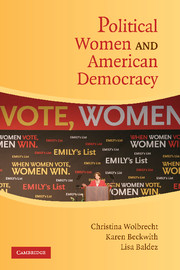Book contents
- Frontmatter
- Contents
- Preface
- List of Contributors
- Political Women and American Democracy
- 1 Introduction: What We Saw at the Revolution: Women in American Politics and Political Science
- 2 Gender as a Category of Analysis in American Political Development
- 3 Gender, Public Opinion, and Political Reasoning
- 4 Gender in the Aggregate, Gender in the Individual, Gender and Political Action
- 5 What Revolution? Incorporating Intersectionality in Women and Politics
- 6 Women's Movements and Women in Movements: Influencing American Democracy from the “Outside”?
- 7 Representation by Gender and Parties
- 8 Women as Candidates in American Politics: The Continuing Impact of Sex and Gender
- 9 Women as Officeholders: Linking Descriptive and Substantive Representation
- 10 Theorizing Women's Representation in the United States
- 11 Political Women in Comparative Democracies: A Primer for Americanists
- 12 Conclusion: Between Participation and Representation: Political Women and Democracy in the United States
- References
- Index
12 - Conclusion: Between Participation and Representation: Political Women and Democracy in the United States
Published online by Cambridge University Press: 05 September 2012
- Frontmatter
- Contents
- Preface
- List of Contributors
- Political Women and American Democracy
- 1 Introduction: What We Saw at the Revolution: Women in American Politics and Political Science
- 2 Gender as a Category of Analysis in American Political Development
- 3 Gender, Public Opinion, and Political Reasoning
- 4 Gender in the Aggregate, Gender in the Individual, Gender and Political Action
- 5 What Revolution? Incorporating Intersectionality in Women and Politics
- 6 Women's Movements and Women in Movements: Influencing American Democracy from the “Outside”?
- 7 Representation by Gender and Parties
- 8 Women as Candidates in American Politics: The Continuing Impact of Sex and Gender
- 9 Women as Officeholders: Linking Descriptive and Substantive Representation
- 10 Theorizing Women's Representation in the United States
- 11 Political Women in Comparative Democracies: A Primer for Americanists
- 12 Conclusion: Between Participation and Representation: Political Women and Democracy in the United States
- References
- Index
Summary
We need to know why democratic representative institutions do not work for women as well as they work for powerful men, and we need to know what conditions contribute to those institutions working better for women.
(Dovi, this volume, 148)How democratic has U.S. democracy been for women? How political have U.S. women become since “the revolution” (Wolbrecht, this volume)? Certainly since the publication of Jeane J. Kirkpatrick's Political Woman in 1974, there has been a revolution in women's political and legal status, mass participation, feminist movement activism, and voting behavior. Political Woman, politically active women, and a highly political women's movement emerged alongside important legislative achievements (e.g., the proposal of the Equal Rights Amendment in 1972 and passage of Title IX in 1974), landmark Supreme Court decisions (most notably Roe v. Wade in 1973), and significant implementation of antidiscrimination laws by the Equal Employment Opportunity Commission.
What have been the subsequent impacts and political trajectory of this revolution of political women? What do we know about political women and democracy in the United States? The chapters in this volume, in answering these questions, share two major commonalities at their outset: their attention to distinctions of “sex” and “gender,” and their appreciation of the impact of gendered institutions on political women and of political women's influence in gendering political parties, policy processes, and state structures.
- Type
- Chapter
- Information
- Political Women and American Democracy , pp. 181 - 198Publisher: Cambridge University PressPrint publication year: 2008
- 1
- Cited by



